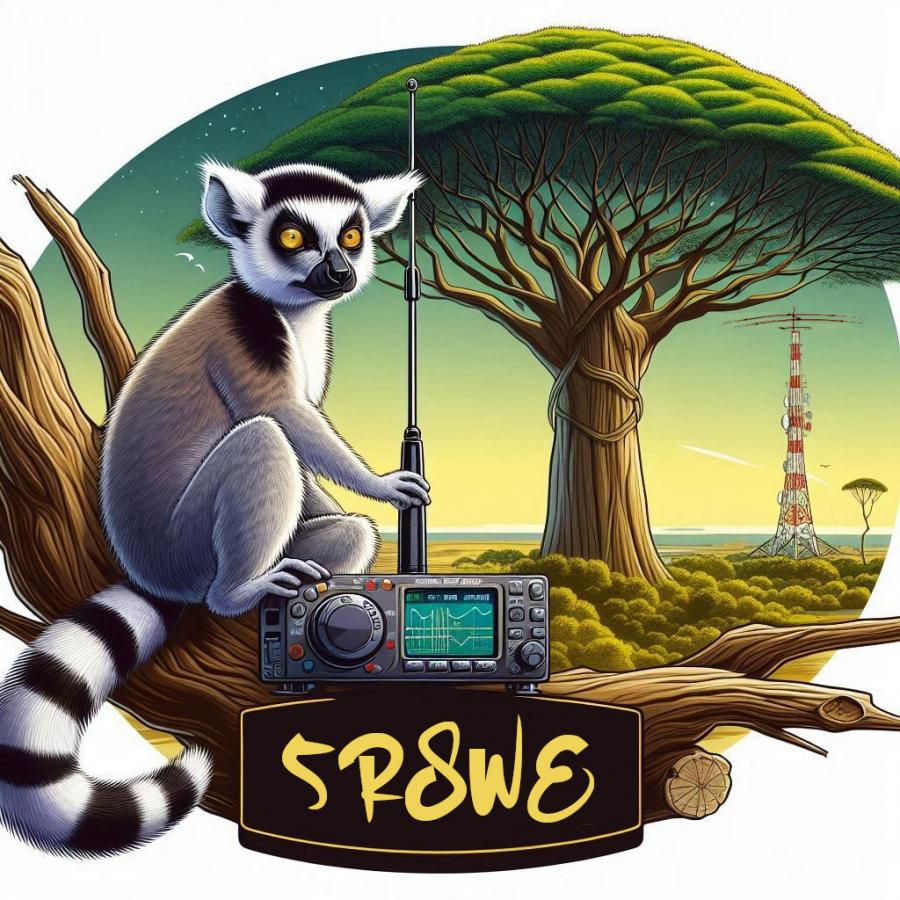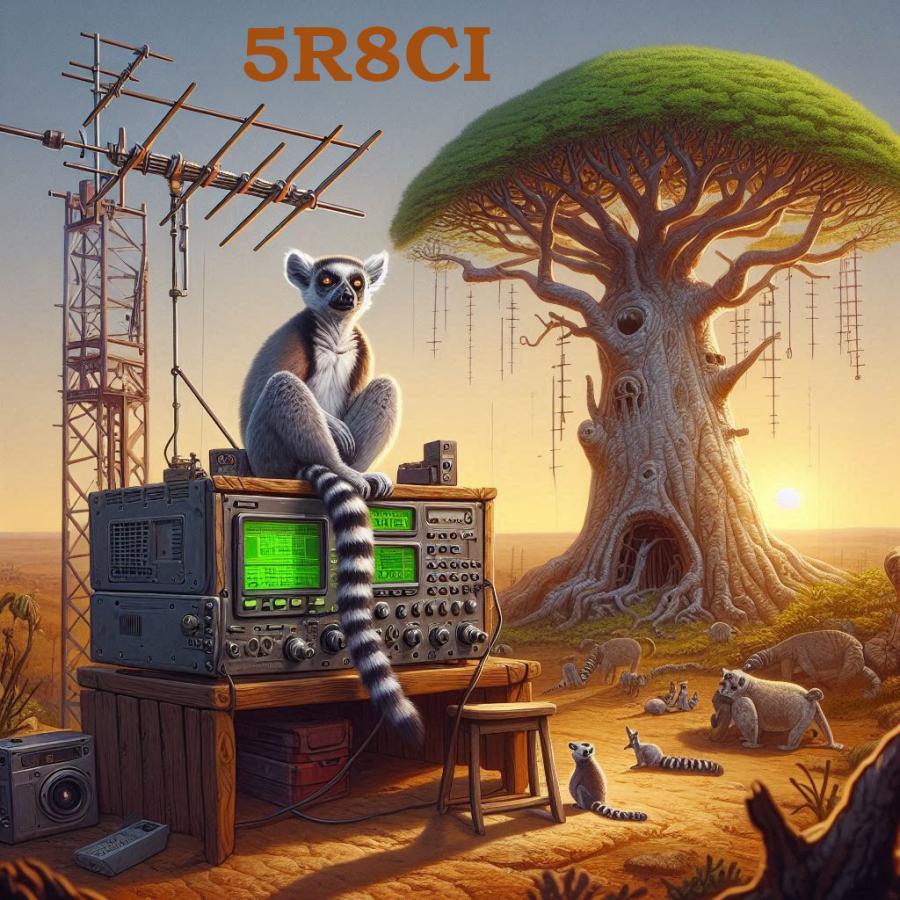SP9FIH and SP6CIK will be active as 5R8WE and 5R8CI from Andilana, Nosy Be Island, IOTA AF - 057, Madagascar, 23 October - 6 November 2024.
They will operate on 40 - 10m Bands, CW, SSB, FT8, Super Fox.
Recent DX Spots 5R8WE
5R8WE Log search5R8CI Log searchRecent DX Spots 5R8CI
QSL via LOTW, ClubLog OQRS.
Madagascar is an island with unique flora and fauna
Lemurs, chameleons and baobabs are the first things that come to mind when the name of the island of Madagascar is mentioned. ‘The land at the end of the world’ is exactly what the locals call it. It's not easy to get here, but it's even harder to get to the island and not marvel at its beauty. It is a completely different world, practically untouched by civilisation.
 Nosy Be Island, Madagascar. Author - Gialivra10.
Nosy Be Island, Madagascar. Author - Gialivra10.
Endemic flora and fauna under threat
Madagascar's fauna and flora are unique and diverse. About 90 per cent of all plants and animals are endemic, i.e. found nowhere else in the world. The island is considered a refuge for many rare, endangered species. The most famous inhabitants of Madagascar are lemurs (including the potbellied lemur, varis and white sifak), chameleons, iguanas and geckos. Black and sandalwood trees, baobabs and aloe trees can be seen here.
Madagascar still hides many riddles and mysteries, but with the development of civilisation they are becoming less and less. Human activity is responsible for the destruction of the natural landscape and the gradual clearing of tropical forests. Among other things, some species of animals have been introduced to the island that have never been present in the region. This has had a detrimental effect on the population of native wildlife.
One example is the Asian toad (Duttaphrynus melanostictus), which was probably brought to Madagascar by sea travellers. This amphibian releases deadly toxins (a predator is doomed to agony after hunting a toad), spreads disease and has an unbridled appetite. With its existence, the amphibian is causing irreparable damage to an island that has been completely isolated for several hundred years.

History of Madagascar: French, Slovaks and corsairs
Madagascar has an extremely interesting history. It was a trade route connecting the Arab world to the east coast of Africa. Europeans only discovered the island in the fifteenth century thanks to Portuguese ships sailing to India.
In the 17th century, the French came to Madagascar. They immediately began using the local population as cheap labour. Such activities of Europeans unexpectedly faced a serious rebuff in the face of pirates, who perceived the local population as a good source of income. The corsairs also considered the island a popular holiday destination. Here they even had their own informal state with a government and laws.
The confrontation between the French and the corsairs is considered one of the most dangerous and at the same time extremely interesting periods in the history of the island. To commemorate it, the Pirates' Museum in the capital Antananarivo is open and operational.
Madagascar also has a definite Slovak period in its turbulent history. In 1773, the French government sent Lieutenant Colonel Mauricio von Bieniowski on a mission to conquer new lands in the east. The famous Hungarian-Slovak adventurer and traveller immediately sailed to the island and was soon proclaimed king. He managed to capture the capital of the country and built several fortifications on its territory.
In the eighteenth century, the French finally defeated the corsairs and managed to gain the support of the local rulers. In the nineteenth century, the island officially became a French colony.
In the 20th century, nationalist movements intensified in Madagascar, thanks to which it gained the status of an overseas colony. However, it was not until 1960 that the state finally gained sovereignty.
As a reminder of the centuries-long presence of the French, today French is the official language on the island, in addition to Malagasy.

What you need to know about 21st century Madagascar
Madagascar is an island in the western Indian Ocean, separated from the south-eastern coast of Africa by a distance of 800 kilometres. The country, which gained independence only 60 years ago, is now inhabited by about 21 million people. Europeans discovered the island not so long ago, thanks to which it still keeps many secrets and mysteries.
In the 21st century Madagascar gained unprecedented popularity in pop culture thanks to the Hollywood animated film with the same name. It is noteworthy that the main characters of the animated film ‘Madagascar’ - animals: lions, giraffes, hippos, penguins and zebras have never actually lived on the island.
But despite this, tourists here still have a lot to see. The main magnet is the unusual contrasting landscapes, which can't be compared to any other place in the world.
The best time for a tourist trip to Madagascar is from October to December and from March to May. It is during these months that the island experiences the most comfortable temperatures. The average warmth in the capital Antananarivo in July is + 15 °C and in February it is around + 25 °C.
Madagascar has an area of 588000 square kilometres, making it one of the largest islands in the world. Its size is second only to Greenland, New Guinea and Borneo.
According to scientists, millions of years ago Madagascar was part of the African continent. According to another version, it was inseparable from modern Asia, and in particular the supercontinent Gondwana. But about 88 million years ago there was a tectonic split, which caused Madagascar to separate from the Indian Peninsula.
Currently, the island belongs to modern Africa. It is ruled by Heri Rajaonarimampian. The current president of Madagascar is known for having the longest name among other leaders of states.
As for religion, Christianity prevails on the island, which gained a strong position thanks to French missionaries. At the same time, a certain part of the population still professes Animism - the belief in the existence of the soul, spirits and animated nature. Animists worship the magical powers of their ancestors, so many of the deceased adherents of the religion find their resting place on the uplands, in caves and rocks. Thus, becoming closer to the older generations of ancestors in heaven.
Up to 90 per cent of the endemic species that inhabit the island are found in the rocky massif of Tsingy de Bemaraha, which is inaccessible to humans. However, this annoyance is more than compensated for by the animals that have become Madagascar's trademark - lemurs. They resemble something between a cat, a squirrel and a dog. In addition to lemurs, there are about 80 species of snakes on the island. But there is no need to worry about this, as none of the snakes are poisonous.
Madagascar is the leader in vanilla production. About 80 per cent of the world's exports are concentrated here. Also the island is one of the largest suppliers of coffee, lychee and shrimp.
Agriculture, fishing and herding are the main means of livelihood for the locals of Madagascar. However, about 69 per cent of the island's population lives below the poverty line. They are predominantly rural people who are forced to feed themselves and their families for as little as one dollar a day.
Those travelling to these areas should be on their guard, as petty crime has increased dramatically in recent years. Tourists are advised not to go out after dark and not to flaunt precious items.

